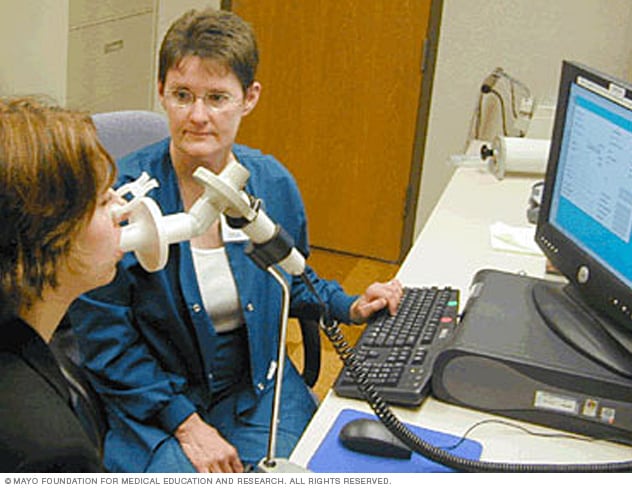Diagnosis
During the physical exam, your doctor will use a stethoscope to listen carefully to your lungs while you breathe. To distinguish pneumonitis from other lung disorders, you'll likely have one or more of the following tests.
Blood tests
Certain blood tests can be useful for pinpointing a diagnosis.
Imaging tests
Imaging tests are useful because in most cases, pneumonia affects only a small, localized portion of your lungs, while the effects of noninfectious pneumonitis are often spread throughout all five lobes of your lungs.
- Chest X-ray. This painless test causes a small amount of radiation to pass through your chest to produce images of your lungs. X-rays take only a few minutes to perform.
- Computerized tomography (CT). CT scans combine X-ray images taken from many different angles into detailed cross-sectional images. This painless test involves lying on a narrow table that slides into a large, doughnut-shaped machine. CT scans typically take less than 15 minutes to perform. Computerized tomography gives much greater detail of changes in your lungs than what a chest X-ray can provide.
Pulmonary function tests
A test called spirometry measures the amount of air that you're able to inhale and exhale in a specific period of time. Your doctor may also measure how efficiently your lungs transfer gases from the air into the bloodstream during exercise.
Another way to assess how well your lungs are working is to measure the oxygen in your blood with an oximeter — a device that painlessly clamps on your finger.
 Spirometer
Spirometer
A spirometer measures how much air your lungs can hold and how quickly you can breathe out.
Bronchoscopy
A bronchoscopy is a procedure that uses a flexible tube threaded down your throat to view your airways and collect samples from your lungs.
During bronchoscopy, your doctor may flush a section of your lung with a saltwater solution to collect lung cells and other materials. This flushing procedure is known as a lavage. Your doctor may also insert a tiny tool through the scope to remove a small sample of cells from the lung tissue for testing.
Surgical lung biopsy
In some cases, your doctor may want to examine larger samples of tissue from several locations in your lungs that cannot be reached via bronchoscopy. A surgical procedure to obtain these samples may be necessary.
More Information
Treatment
If you have hypersensitivity or chemical pneumonitis, your doctor will recommend eliminating exposure to the allergen or chemical irritating your lungs. This step should help lessen your symptoms.
In severe cases of pneumonitis, treatment may also include:
- Corticosteroids. These drugs work by suppressing your immune system, reducing inflammation in your lungs. Corticosteroids are usually taken as a pill. However, long-term corticosteroid use also increases your risk of developing infections and is associated with the thinning of bones (osteoporosis).
- Oxygen therapy. If you're having a lot of trouble breathing, you may need oxygen therapy through a mask or plastic tubing with prongs that fit into your nostrils. Some people need oxygen therapy constantly, while others might need it only during exercise or sleep.
Lifestyle and home remedies
A diagnosis of pneumonitis may mean that you'll have to make changes to your lifestyle to protect your health. You'll need to avoid known triggers as much as possible.
For example, if your job duties expose you to substances that irritate your lungs, talk to your doctor and supervisor at work about ways to protect yourself, such as wearing a pollen mask or personal dust respirator. If a hobby is causing the problem, you may have to find a different hobby.
Preparing for your appointment
While you may initially consult your family doctor, he or she may refer you to a pulmonologist — a doctor who specializes in lung disorders.
What you can do
You may want to write a list that includes:
- Detailed descriptions of your symptoms, including when they began and if anything seems to make them worse or better
- Detailed list of all jobs and exposures that may have accompanied these occupational activities
- Information about medical problems you've had and their treatments
- Information about the medical problems of your parents or siblings
- All the medications and dietary supplements you take or have taken in the last few years?
- Questions you want to ask the doctor
What to expect from your doctor
A thorough medical history and physical exam can provide important clues about what might be causing your symptoms. Your doctor may ask some of the following questions:
- Do you now or have you ever smoked tobacco?
- What types of jobs or hobbies have you had?
- How does the severity of your breathing symptoms relate to your work or hobby schedules?
- Do you have a hot tub or humidifier at home?
- Are you ever around pigeons or pet birds?